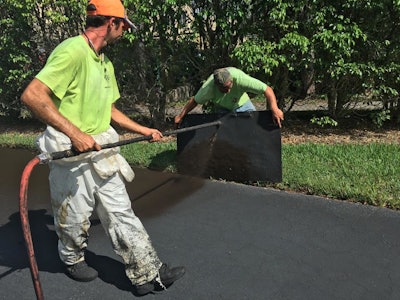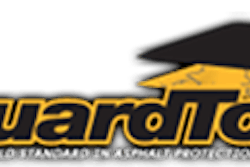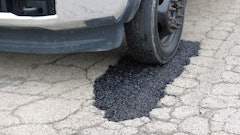
While we all know the benefits of sealcoating to a pavement, the biggest reason most consumers want their parking lots sealcoated is curb appeal. They want a parking lot that looks good for their customers and it’s your job to deliver that.
Whether you’re using a spray wand or a squeegee to apply your sealcoating materials, keeping those edges clean can impact the entire look of the job so it’s important to take extra care around the edges to maintain a clean and uniform look.
The Clean Edge
“The biggest goal in edging sealer is the obvious, keep it off the adjoining surface whether it be concrete, grass, etc,” says Nick Howell, owner of T&N Asphalt Services. “The process of edging also happens to be one of the most time consuming parts of sealing in my opinion, but one that can help to make or break the looks of a job.”
One of the most important aspects of edging or “cutting in” is to start with a properly prepared surface. In order for sealcoat to achieve proper adhesion, it is vital that the surface in thoroughly cleaned. For edging, you will want to ensure that all dirt and debris have been removed, and that if there is a gap or separation between the asphalt and a concrete or block edge that it is also cleaned out. To achieve this, contractors may use backpack or walk behind blowers, wire bristle brooms, edging tools and sometimes power washers.
“Many contractors prefer to use brushes or squeegees for edging because they have more control over the sealer, and are not subject to the effects of wind,” says John Capretz, owner of Panther Equipment, LLC. “However, when using a brush or squeegee for edging, the amount of material applied becomes one of the most important aspects. Contractors want to apply “just the right amount” of sealer along the edge prior to applying it, which requires some practice. If you put down too much, you will spend extra time spreading the material out to achieve the appropriate coverage. On the other hand, if you put down too little material, you will end up having to come back to apply more material to achieve appropriate coverage. Either of these situations have the potential to put a significant damper on your efficiency, and ultimately your profitability. So, it is important to pay attention to how much sealer is going down.”
“If you are using a squeegee or brush, we have found you have much more control and less chance of flipping material onto the surface if you pull the squeegee or brush rather than push it,” Howell adds.
Tools of the Trade
Since the look of a sealcoated edge is so important, there are several tools that can help improve the process.
For sealcoating edges, contractors can use brushes, squeegees, spray wand and blocker boards. Then there are also specialized tools that have been developed just for sealcoating around edges.
“Brushes are popular because they offer a lot of control over the sealer,” Capretz says. “Brushes come in various types ranging from stiff nylon to softer natural fibers. The stiffer brushes offer more control over the sealer, but the softer brushes can offer smoother application, leaving fewer brush marks. Squeegees allow contractors to avoid brush marks altogether, but they often only perform well on certain asphalt. On older, uneven asphalt, they tend to leave too much material behind, and on new, smooth asphalt, they tend to remove too much."
The main tool used to avoid overspray is using a blocker board when edging. However, contractors must be mindful of overspray even when they are spraying the central areas inside the edged perimeter, especially if wind is present. The operator must be mindful of the strength and direction of the wind at all times, and adjust their spraying accordingly. It is important to overlap spray slightly on to the edged perimeter to minimize the transition between the sprayed interior and the brushed perimeter for aesthetic purposes.
“Some contractors prefer to edge using a spray wand and a blocker board," Capretz says. "Spraying can offer a clean edge, but contractors must be very mindful not only of overspray, but also of the blocker board and the sealer that accumulates on it. It can become tricky moving the board from one location to another without having sealer drip on to the surfaces you are trying to protect. Spraying is also susceptible to the effects of wind.”
“Care also needs to be taken around landscaping, all too often I see guys that are less than careful around grass, only to have overspray hold up payment,” Howell says. “Spraying is usually the quickest way to edge and what we do, but does require skill and a good eye to watch for over spray issues and also making sure the coverage is good.”
Specialized tools, such as the Panther Auto-Flow Brush system can offer advantages over traditional methods. The system utilizes a standard nylon strip brush, but the sealer is delivered down a wand directly to the brush. This allows the operator to accurately control the amount of sealer being applied, and allows it to effectively dispense and apply sealcoat in a single step. These tools can offer advantages over conventional methods in terms of speed, efficiency and convenience.
Spray shields that attach directly to the want can also be used to help avoid overspray around edges.
“For edging areas that join up to asphalt, we still spray, but use tar paper,” Howell says. “You can also squeegee or brush and use tar paper as guide. Using tar paper leaves the best edge you can get. We use it anywhere that we don't have concrete or some other surface to seal up to.”






![[VIDEO] Caterpillar Highlights Features of New PM620 Milling Machine](https://img.forconstructionpros.com/files/base/acbm/fcp/image/2016/04/default.5706a8c41d20d.png?auto=format%2Ccompress&fit=crop&h=167&q=70&w=250)













